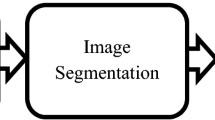Abstract
Breast cancer is one of the common disease in female gender population all over the world. The classical methods of segmentation and classification for malignant cells are not only repetitive but also very time-consuming. Therefore, a computer-aided diagnosis is needed for automatic segmentation and classification of malignant cells in breast cytology images. In this article, a machine learning-based approach is proposed for malignant cell segmentation and classification in breast cytology images. In the proposed approach, the segmentation of cells is performed by a level set algorithm which is used to extract statistical information related to the malignant and benign cells. Similarly, the gray level co-occurrence matrix is computed to exploit the texture information, and support vector machine-based classification is used for the classification of malignant and benign cells. It has been observed through experiments that the proposed approach achieved high accuracy (96.3%) in the classification of malignant and benign cells.




Similar content being viewed by others
Explore related subjects
Discover the latest articles, news and stories from top researchers in related subjects.References
McGuire S (2016) World cancer report (2014) Geneva, Switzerland: World health organization, international agency for research on cancer, WHO Press, 2015. Adv Nutr Int Rev J 7(2):418–419
Gordon PB (2005) Image-directed fine needle aspiration biopsy in nonpalpable breast lesions. Clin Lab Med 25(4):655–678
Sayed GI, Hassanien AE (2017) Moth-flame swarm optimization with neutrosophic sets for automatic mitosis detection in breast cancer histology images. Appl Intell 47(2):397–408
Spanhol FA, Oliveira LS, Petitjean C, Heutte L (2015) A dataset for breast cancer histopathological image classification. IEEE Trans Biomed Eng 63(7):1455–1462
Carvalho ED, Antônio Filho O, Silva RR, Araújo FH, Diniz JO, Silva AC, Paiva AC, Gattass M (2020) Breast cancer diagnosis from histopathological images using textural features and CBIR. Artif Intell Med 105:101845
Dhahri H, Al Maghayreh E, Mahmood A, Elkilani W, Faisal Nagi M (2019) Automated breast cancer diagnosis based on machine learning algorithms. J Healthc Eng. https://doi.org/10.1155/2019/4253641
Karthiga R, Narasimhan K (2018) Automated diagnosis of breast cancer using wavelet based entropy features. In: 2018 Second international conference on electronics, communication and aerospace technology (ICECA), pp 274–279
Vo DM, Nguyen NQ, Lee SW (2019) Classification of breast cancer histology images using incremental boosting convolution networks. Inf Sci 482:123–138
Goudas T, Maglogiannis I (2015) An advanced image analysis tool for the quantification and characterization of breast cancer in microscopy images. J Med Syst 39(3):31
George YM, Zayed HH, Roushdy MI, Elbagoury BM (2014) Remote computer-aided breast cancer detection and diagnosis system based on cytological images. IEEE Syst J 8(3):949–964
Bergmeir C, Silvente MG, Benítez JM (2012) Segmentation of cervical cell nuclei in high-resolution microscopic images: a new algorithm and a web-based software framework. Comput Methods Programs Biomed 107(3):497–512
Mouelhi A, Sayadi M, Fnaiech F, Mrad K, Romdhane KB (2013) Automatic image segmentation of nuclear stained breast tissue sections using color active contour model and an improved watershed method. Biomed Signal Process Control 8(5):421–436
Filipczuk P, Fevens T, Krzyzak A, Monczak R (2013) Computer-aided breast cancer diagnosis based on the analysis of cytological images of fine needle biopsies. IEEE Trans Med Imaging 32(12):2169–2178
Krawczyk B, Filipczuk P (2014) Cytological image analysis with firefly nuclei detection and hybrid one-class classification decomposition. Eng Appl Artif Intell 31:126–135
Khan SU, Islam N, Jan Z, Shah HU, ud Din A (2018) Automated counting of cells in breast cytology images using level set method. In: 2018 IEEE 20th international conference on high performance computing and communications; IEEE 16th international conference on smart city; IEEE 4th international conference on data science and systems (HPCC/SmartCity/DSS), pp 1578–1584
Ghani ASA, Aris RSNAR, Zain MLM (2016) Unsupervised contrast correction for underwater image quality enhancement through integrated-intensity stretched-Rayleigh histograms. J Telecommun Electron Comput Eng (JTEC) 8(3):1–7
Stark JA (2000) Adaptive image contrast enhancement using generalizations of histogram equalization. IEEE Trans Image Process 9(5):889–896
Osher S, Fedkiv R, Deckelnick K (2006) Buchbesprechungen-level set methods and dynamic implicit surfaces. Jahresbericht der Deutschen Mathematiker Vereinigung 108(4):11
Yezzi A, Kichenassamy S, Kumar A, Olver P, Tannenbaum A (1997) A geometric snake model for segmentation of medical imagery. IEEE Trans Med Imaging 16(2):199–209
Caselles V, Catté F, Coll T, Dibos F (1993) A geometric model for active contours in image processing. Numer Math 66(1):1–31
Al-Dulaimi K, Tomeo-Reyes I, Banks J, Chandran V (2016) White blood cell nuclei segmentation using level set methods and geometric active contours. In: International conference on digital image computing: techniques and applications (DICTA), pp 1–7
Salman NH (2009) Level set methods implementation for image levelsets and image contour. IJCSNS 9(11):199
Airouche M, Bentabet L, Zelmat M ((2009)) Image segmentation using active contour model and level set method applied to detect oil spills. In: Proceedings of the world congress on engineering, vol 1, pp 1–3
Vapnik V (1998) Statistical learning theory. Wiley, New York
Byun H, Lee SW (2003) A survey on pattern recognition applications of support vector machines. Int J Pattern Recognit Artif Intell 17(03):459–486
Alqudah A, Alqudah AM (2019) Sliding window based support vector machine system for classification of breast cancer using histopathological microscopic images. IETE J Res. https://doi.org/10.1080/03772063.2019.1583610
Zemmal N, Azizi N, Dey N, Sellami M (2016) Adaptive semi supervised support vector machine semi supervised learning with features cooperation for breast cancer classification. J Med Imaging Health Inf 6(1):53–62
Gupta V, Bhavsar A (2017) Breast cancer histopathological image classification: is magnification important? In: Proceedings of the IEEE conference on computer vision and pattern recognition workshops, pp 17–24
Author information
Authors and Affiliations
Corresponding author
Additional information
Publisher's Note
Springer Nature remains neutral with regard to jurisdictional claims in published maps and institutional affiliations.
Rights and permissions
About this article
Cite this article
Khan, S.U., Islam, N., Jan, Z. et al. A machine learning-based approach for the segmentation and classification of malignant cells in breast cytology images using gray level co-occurrence matrix (GLCM) and support vector machine (SVM). Neural Comput & Applic 34, 8365–8372 (2022). https://doi.org/10.1007/s00521-021-05697-1
Received:
Accepted:
Published:
Issue Date:
DOI: https://doi.org/10.1007/s00521-021-05697-1




